El blog donde yo escribo todo lo que llevo dentro, y me expreso libremente. Simplemente Mis cosas :)
viernes, 31 de mayo de 2019
vientos del cambio
Escuchando el viento de cambio,
una noche de verano en agosto.
Soldados que pasan de largo,
escuchando el viento de cambio
El mundo acercándose,
¿pensaste alguna vez
que podríamos estar tan juntos, como hermanos?
El futuro está en el aire,
puedo sentirlo en todas partes,
soplando con el viento de cambio.
Llévame a la magia del momento,
en una noche de gloria.
Donde los niños del mañana sueñan
con el viento de cambio.
Caminando calle abajo,
recuerdos distantes
están enterrados para siempre en el pasado.
Yo sigo el Moskva
hacia el Parque Gorky.
Escuchando el viento de cambio.
Llévame a la magia del momento,
en una noche de gloria.
Donde los niños del mañana comparten sus sueños
contigo y conmigo.
Llévame a la magia del momento,
en una noche de gloria.
Donde los niños del mañana sueñan
con el viento de cambio.
El viento de cambio sopla directo hacia
la cara de tiempo.
Como una tormenta que hará sonar
la campana de la libertad para la paz del espíritu.
Deja que tu balalaika (guitarra rusa) cante,
lo que mi guitarra quiere decir.
Llévame a la magia del momento,
en una noche de gloria.
Donde los niños del mañana comparten sus sueños
contigo y conmigo.
Llévame a la magia del momento,
en una noche de gloria.
Donde los niños del mañana sueñan
con el viento de cambio.
Scorpions - Viento de cambio.
lunes, 27 de mayo de 2019
domingo, 26 de mayo de 2019
miércoles, 1 de mayo de 2019
The Orientalist art movement saw many western artists who travelled through the Near and Middle East from the start of the nineteenth century, painting their experiences as they traversed countries such as Turkey, Persia, Iraq, Egypt, Lebanon and Palestine.
Many of Joseph Austin Benwell's larger artworks (watercolour/gouache) were of the Orientalist style and date from the later part of his life. It is known that he was travelling in the Near and Middle East around the mid 1860s, in particular Egypt and Palestine from 1865-66. Most of his paintings in this genre were painted from around 1865 up until close to his death in 1886. His subjects were principally Egyptian, Syrian and Arabian, he specialised in Bedouins and their camps and caravans traversing the desert with camels, often with ancient ruins in the background. He often featured the iconic 'white camel' in his paintings.
It was during this period that he exhibited most widely, at institutions including The Royal Academy, The Royal Institute of Painters in Water Colour, Suffolk Street in London, The Royal Society of Artists at Birmingham, The Walker Art Gallery at Liverpool, Manchester City Art Gallery, The Royal Hibernian Academy and The Royal Society of British Artists. He also exhibited at the London International Exhibition of 1873, the Sydney International Exhibition of 1879-80 and the Melbourne International Exhibition (1880-81). A review for the Sydney International Exhibition (10 February 1880) states “’Desert Travelling, Valley of Sinai’ by J A Benwell, a fine sunset effect. A couple of camels labor along in the foreground with that peculiar look of patient endurance with which they are credited, but which is more apparent than real. The color is telling, but subdued.”
Joseph Austin Benwell may not be one of the best known Orientalist artists, although he is referred to in various publications such as 'Les Orientalistes de l' Ecole Britannique' by G M Ackerman, Paris 1991, and 'Les Orientalistes Peintres Voyageurs' by L Thornton, 1983. His paintings command quite high prices at international auction houses today. Some examples of his paintings are shown below.
It seems to be fashionable in these politically correct times, particularly since the publication of Edward Said’s 'Orientalism' (1978), for some to think of orientalist art in somewhat negative and critical terms. Said considered that prejudiced outsider-interpretations of the Eastern world were shaped by the cultural attitudes of European imperialism in the 18th and 19th centuries. Said was of the opinion that Orientalism created patronising and possibly demeaning views of the non-Western world. It is true that some Orientalist artists may have painted what could be considered as somewhat risqué or condescending scenes. But Benwell, like most other Orientalist artists, was most definitely a realist, working with dedication and enthusiasm to accurately depict what he saw on his travels in the Orient. Working within the social and political conditions prevalent at the time, such artists have provided us with a valuable ‘snapshot’ and record of life in these countries during a bygone age.
To quote the artist John Singer Sargent: "I do not judge, I only chronicle."
Many of Benwell's Orientalist paintings are listed on websites such as Blouin Art Index Artnet and MutualArt.
As a Benwell descendant, I am interested in acquiring J A Benwell's paintings in order to bring some back to the family. I would be interested to hear from anyone wishing to sell one of his works. Or if you just want to find a good home for a piece that is no longer wanted, please let me know. (please see 'contact' page)
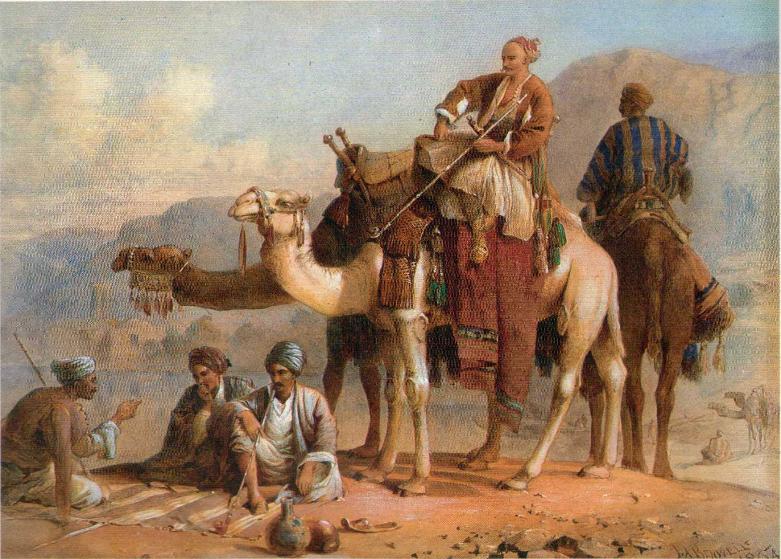
'The Meeting Place', signed and dated 1864.
This watercolour must be one of Benwell's earliest painted Middle-Eastern scenes. At the time , he was still producing wood engravings and black and white illustrations for publications such as The Illustrated London News, and Religious Tract Society journals and books.
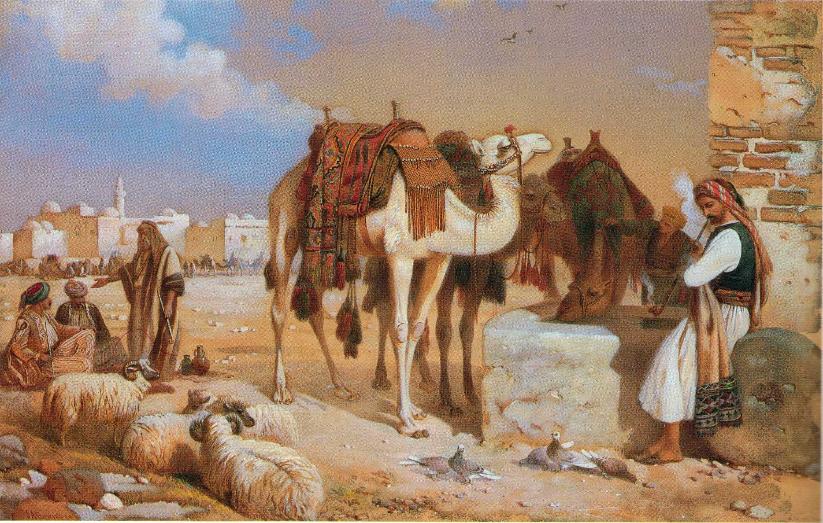
'At the Well' 1871
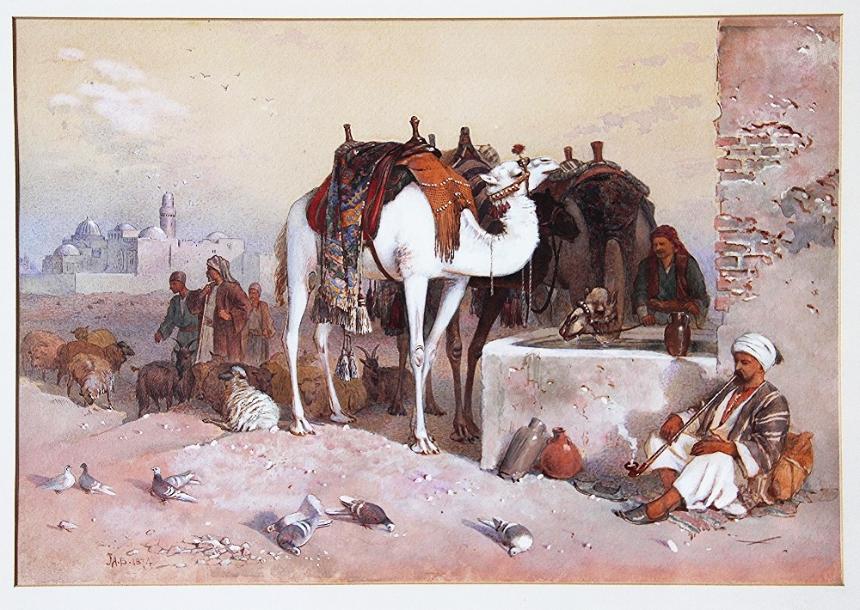
At the Well' version 2, 1874, or - 'Three camels at a water trough with figures, sheep and goats and a temple in the distance'. Initialled JAB 1874 lower left.
Note similarities with the 1871 painting above, and how this painting is a 'variation on a theme' thereof. Benwell would have made sketches on his travels, often completing the actual paintings back in his studio in Kensington. Sometimes he varied the figures and details in each painting, whilst keeping the original composition and overall theme. Another example is shown further down the page - variations of 'An Arab caravan in the Sinai Desert', 'Head of the caravan, Mount Sinai', 'Caravan of camels crossing the desert, mountains beyond' and others are all quite similar but vary in small but distinctive details.
Benwell usually depicted his camels adorned with rich and ornate fabrics over their saddles. These decorative and colourful textiles were also used to make saddle bags to contain the rider's belongings. The tassells hanging below the camel's belly would sway with the camel's gait, serving to keep flies away. These beautiful historical nineteenth century fabrics used with camel saddles in Egypt and the Middle East, as illustrated by Benwell, would surely make an interesting topic for study in itself.
Another of Benwell's paintings was also called 'At the Well' but undated (see below). This signed watercolour heightened with white, 153/4x203/4in (395x520mm) was sold by Christie's on 24 November 1983.
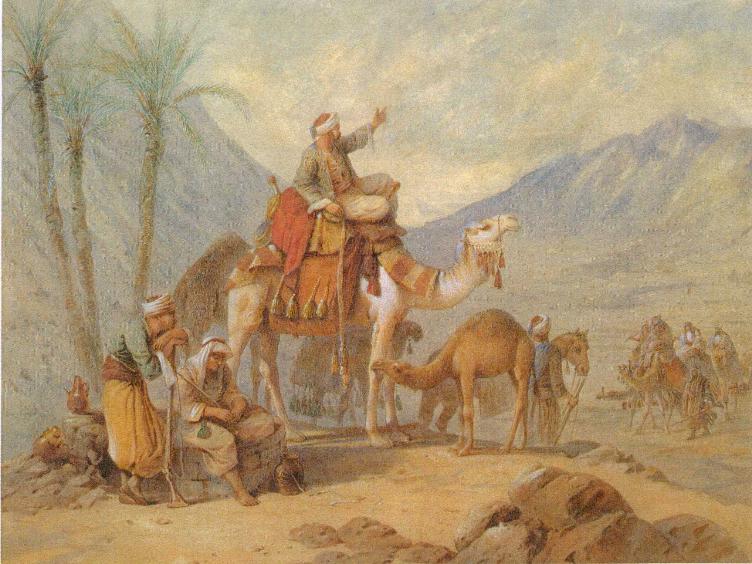
'At the Well'
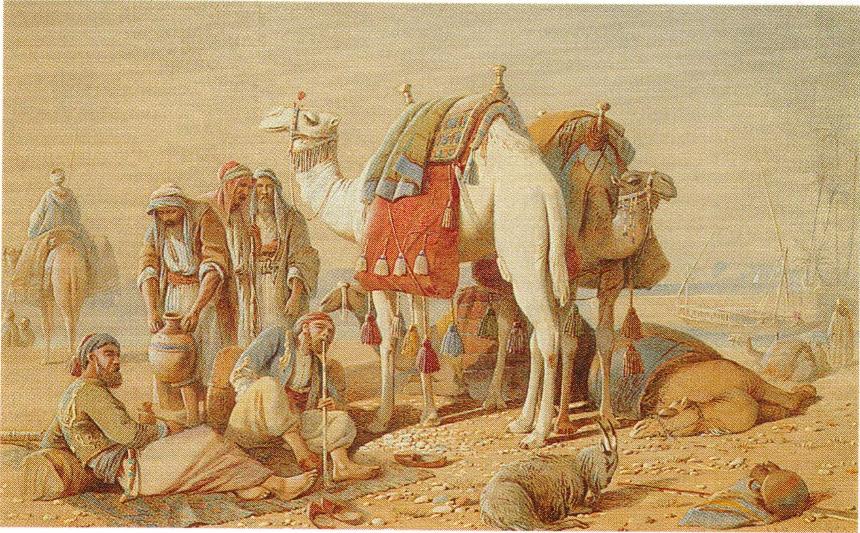
'An Arab caravan resting by the sea' 1865
Watercolour depicting Arab warriors on camel back (no title), undated
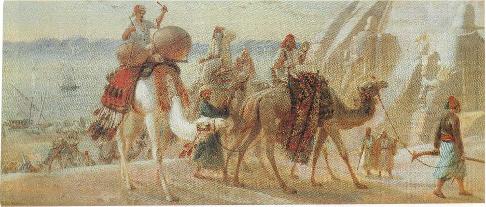
'An Arab Caravan by ruins near the Nile'
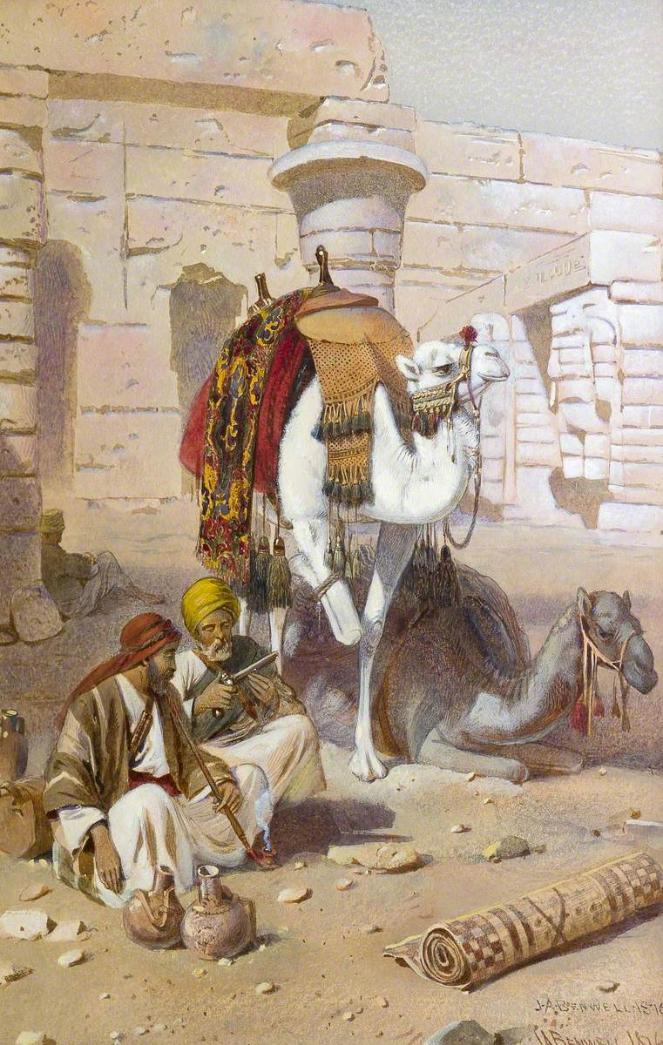
'A Rock Temple in Nubia', 1876
Now held at Russell-Cotes Art Gallery & Museum, Bournemouth. From Art UK website.
Lot 111: A Rock Temple in Nubia, signed and dated twice 'J A Benwell 1876'; pencil and watercolour heightened with bodycolour 12 5/8 x 8 5/8 in. (322 x 220 mm.) Christie’s. London, 11 July 1995. From the similarity in shape of the buildings, and the fact that the temple is in Nubia, it is possible that this painting depicts the Temple of Maharraqa (dedicated to Serapis), Nubia, as does the painting shown below (‘In Nubia, Arabs on camels before the ruins of a Temple’).
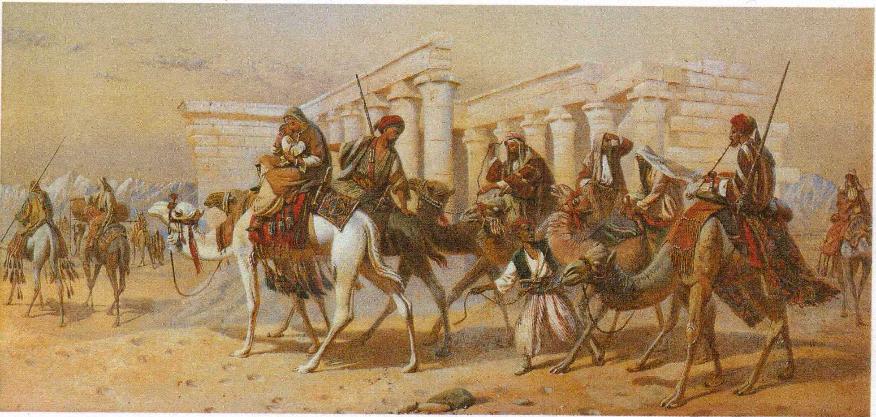
'In Nubia: Arabs on camels before the ruins of a Temple' 1870
The buildings depicted in the background are almost certainly the Temple of Maharraqa (dedicated to Serapis, early images shown below), in the ancient Egyptian region of Maharaka (or Maharraqa), Lower Nubia. The temple was dismantled in 1961 and rebuilt 4 km away as it was threatened by flooding from the Nile by the Aswan Dam construction project.
It could possibly be the painting referred to in the Birmingham Daily Post, 21 May 1881, exhibited at the Birmingham Royal Society of Artists Spring Exhibition 1881- J A Benwell ‘Mecca Pilgrims passing Maharaka, Nubia’ (refer to the section on Provenance, Section 1 Old Newspapers (below).
The painting has been known as ‘In Nubia, Arabs on camels before the ruins of a Temple’(sale Christie's 26 February 1985), and also ‘A Caravan of camels by ruins in the Desert’(sale Sotheby's 17 October 2001).
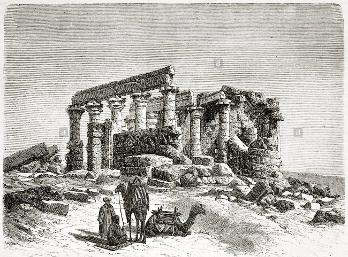
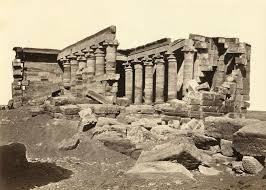
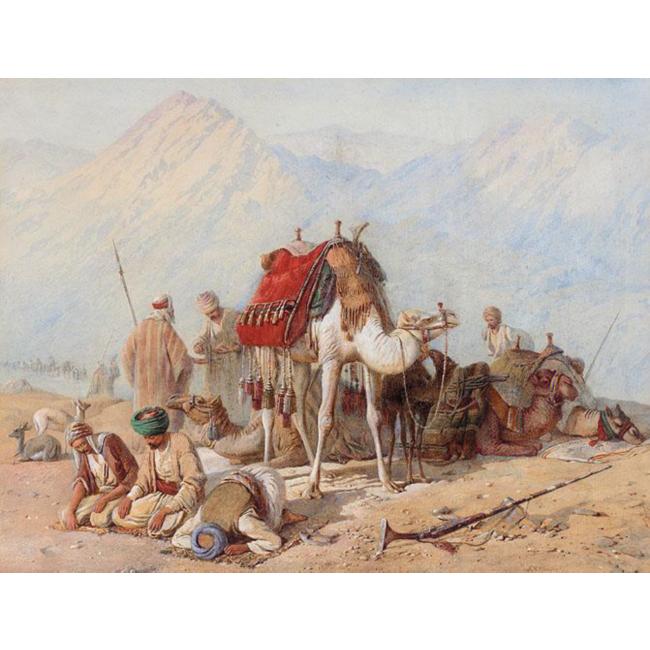
'Arabs Praying in the Desert with a Caravan of Camels beyond'
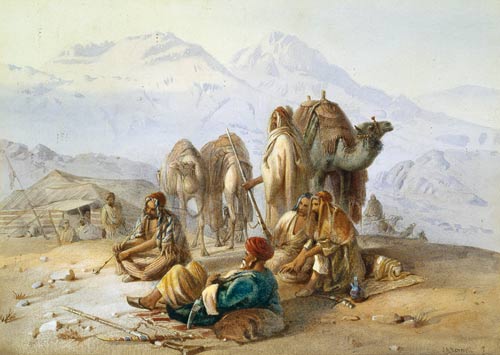
'An Arab Encampment'
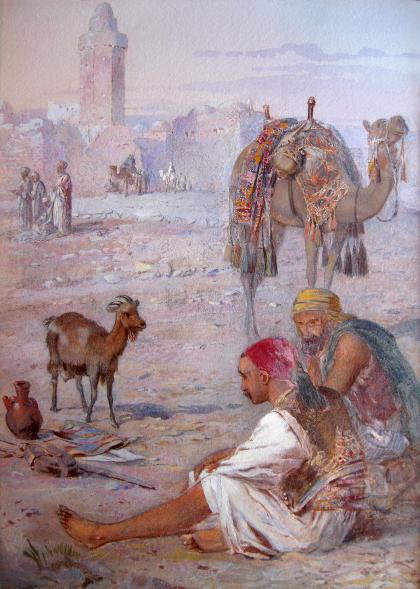
'A Rest before the City Gates' sold Christie's 1 October 2008.
The 'City' could be Jaffa? (see below).
Image size: 13 3/8 x 9 ½ ins.
Previous title 'Arabs resting outside a town' (Lot 173 Christie's sale 29 Nov 1984 and Lot 134, 13 Dec 1983), and 'Arabs resting on the outskirts of a City' (Lot 451, Sotheby's sale 6 Nov 1985).

'Arabs resting outside a Town' signed and dated 1882 from sale at Christie's 13 December 1983. Image size 13 ¾ x 9 7/8 ins. This is slightly larger than the size given in the more recent 2008 sale, due to the 1980s replacement mount covering the edge of the 2008 image..

There is no signature clearly visible on the left hand side image (sold 2008), but this is because it is now mostly hidden under the mount. The date 1880 appears faintly. The signature and date are lower left, below the clump of grass. The painting was sold unframed in the 1984 sale, and a new frame and mount must have been added around that date. The 1983 sale states 'signed and dated 1882' and the 1984 sale states that the painting was dated 1880. In fact, the last digit is not very clear, but on the latest image it looks to be 1880. An enlargement of the black and white photo in the 1983 catalogue is shown above. Note the actual image size in this description (1983) is slightly larger than given in the 2008 description, indicating that the new 1980s mount covers some of the image.
The 'City' in the title could be either Jerusalem, or more likely Jaffa (now part of Tel Aviv). The tower, when zoomed-in on, looks to be six-sided, and there are domed buildings to the right. There is a similarity to the minaret of the Mahmoudiya Mosque at Jaffa, in terms of shape and configuration of the adjoining domed buildings, near the old Jerusalem gate (Abu Nabbut Gate) and the old city walls. Most of the current mosque was built in 1812 by Muhammad Abu-Nabbut, the Governor of Gaza and Jaffa. The rebuilding of the city wall fortifications was completed under Abu-Nabbut from 1810 and onwards. He added a monumental eastern gate crowned with three cupolas. The painting depicts several cupolas or domed-roof buildings with a wall in front. The tower on the painting may have some degree of artistic license, as it appears chunkier than it does in real life. The railings may have been added after the original sketch for this painting was made (probably mid-1860s). Note the Tower of David is circular in girth, not hexagonal as this tower appears to be.
If anyone has any other ideas where this scene could be located, please let me know!
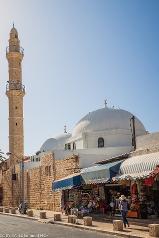
Mahmoudiya Mosque, Jaffa
By Edmund Gall (2014-06 Israel - Tel Aviv 11) [CC BY-SA 2.0 (https://creativecommons.org/licenses/by-sa/2.0)], via Wikimedia Commons)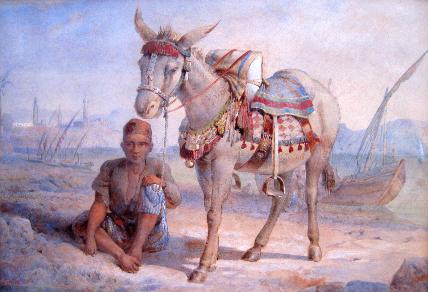
Egyptian Muleteer (or, The Muleteer)
Previous title 'The Egyptian Muleteer' (Lot 406, Sotheby's sale 6 Nov 1985), and likely 'Egyptian Mule Boy' (Lot 122, Phillips sale, Chester, 15 Feb 1985)
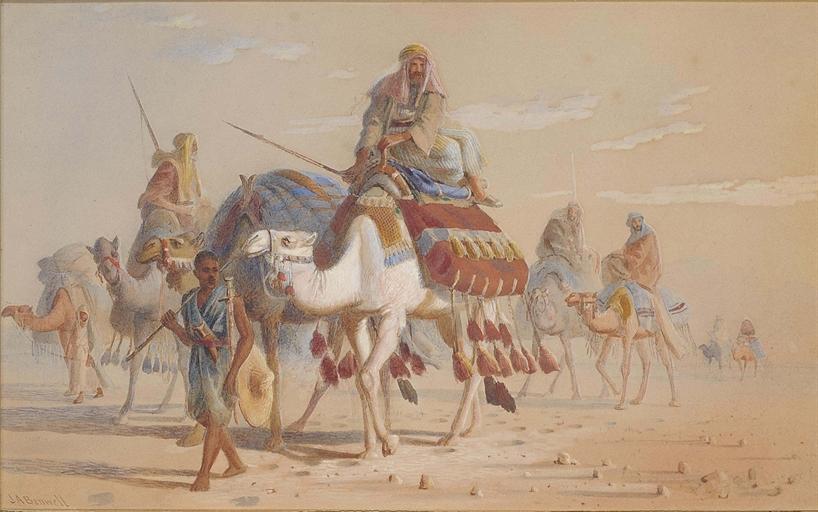
'Crossing the Desert '
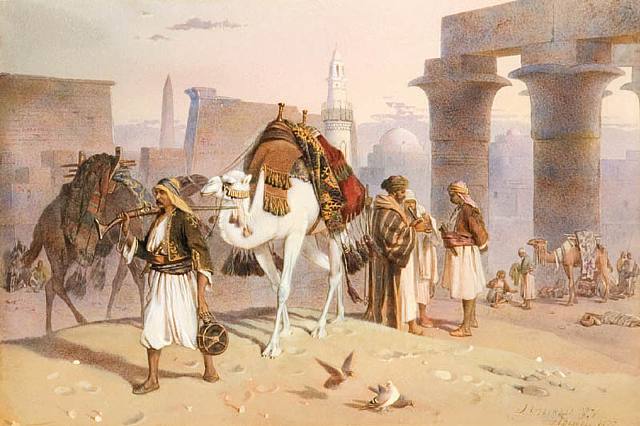
'Travellers at Luxor', 1877
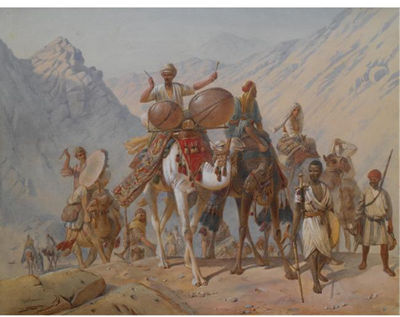
'The Caravan'
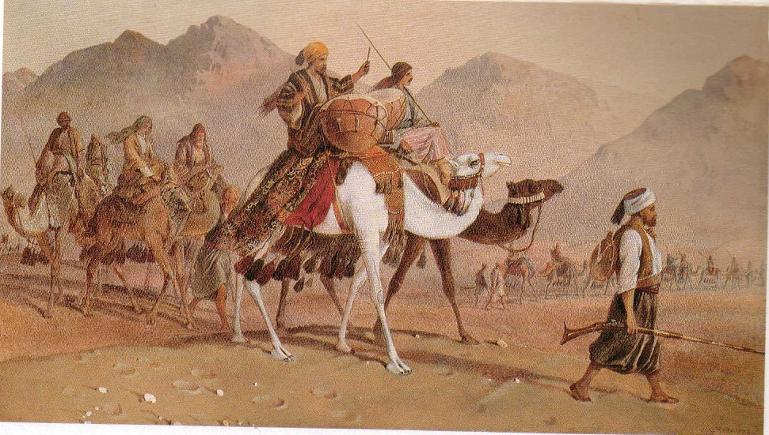
'The Head of the Caravan passing Mount Sinai' 1877
'A group of Arabs at prayer, with distant camels' (or 'Middle Eastern landscape with figures at prayer')
Joseph Austin Benwell’s painting 'A group of Arabs at prayer, with distant camels' (or 'Middle Eastern landscape with figures at prayer') appears to be a replica or exact copy of the very large oil painting 'Prayers in the Desert' (1843); by William James Müller (1812-1845), displayed at the Birmingham Museum and Art Gallery. Benwell’s watercolour, also in an arched mount, is much smaller (c 17cmx30cm) but otherwise identical and is signed J A Benwell lower right.
For more information on this mystery, see 'Benwell, William James Müller and ‘Prayers in the Desert’
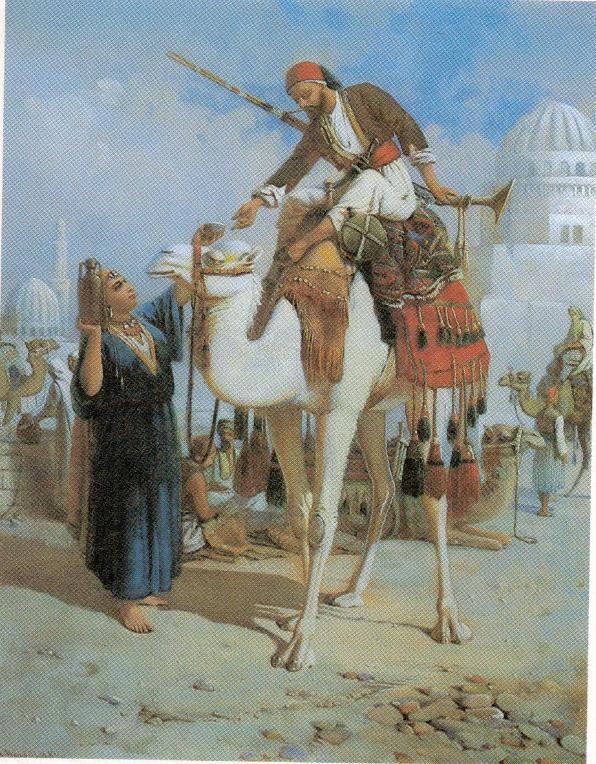
'A Soldier's Refreshment' 1870

'An Arab Caravan' 1877 Lot 176, Christie's 31 October 1989 (signed lower left)
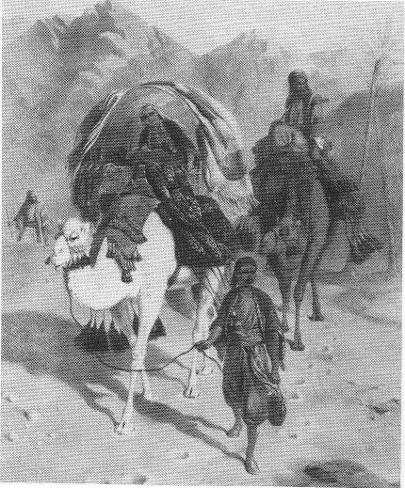
‘Sunset in the Valley of Sinai’ 187_
Note the similarity in subject and style of these paintings (and others on this page), depicting tent-like structures (howdahs) on the backs of camels, usually used for carrying women. In particular the two above ('An Arab Caravan' and 'In the Desert, Sinai', 1877) vary only in very minor details. Why did he sign one lower left, and the other lower right?
Benwell specialised in drawing and painting groups of figures, and this particular subject appears to have been one of his favourite.
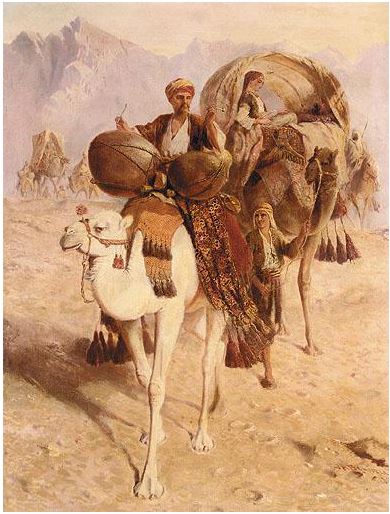
'Caravan of camels crossing the desert, mountains beyond' 1881
'In the Desert, Sinai' 1877, or 'The Caravan' (signed lower right)
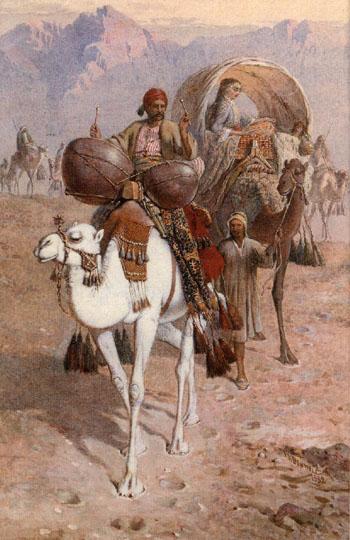
'Head of the caravan, Mount Sinai' 1882
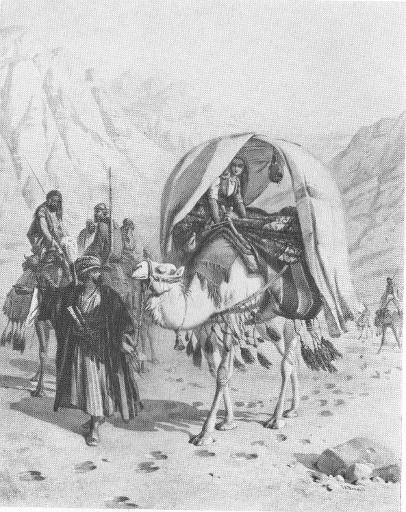
'An Arab Caravan in the Sinai Desert' Lot 223, Christie's 2 November 1979
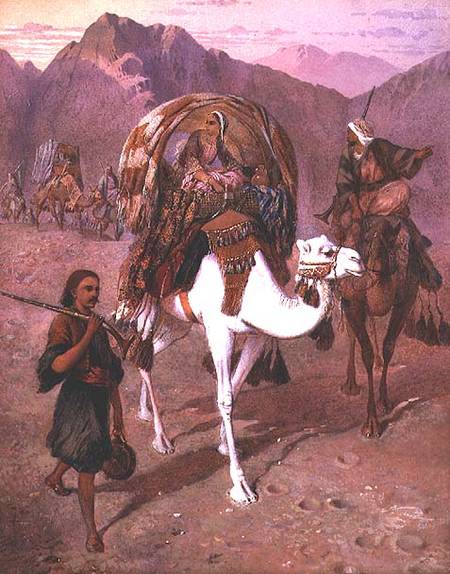
'The Queen of the Caravan' 1881
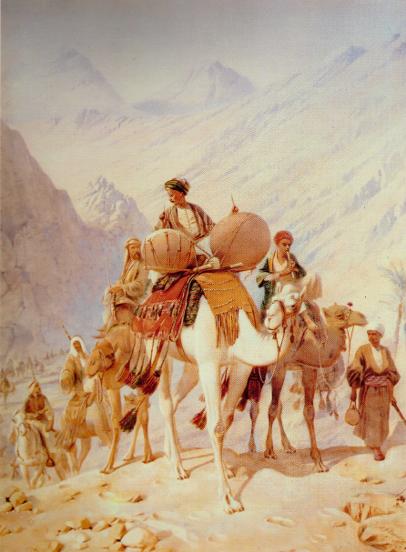
The Head of the Caravan, Valley of Sinai' 1871'
The Head of the Caravan, Valley of Sinai' 1871'
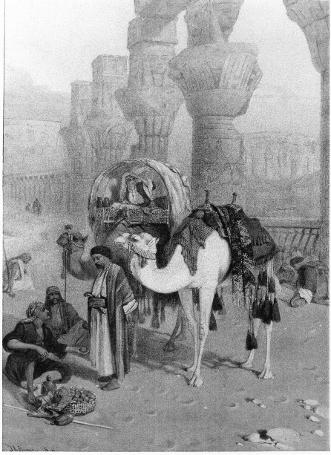
'The Caravan' 1878
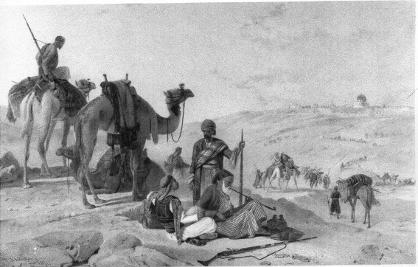
‘An Arab Caravan outside a Town’ 1871

'A Caravan passing the Statues of Memnon in the Plain of Goorna at Thebes' 1876
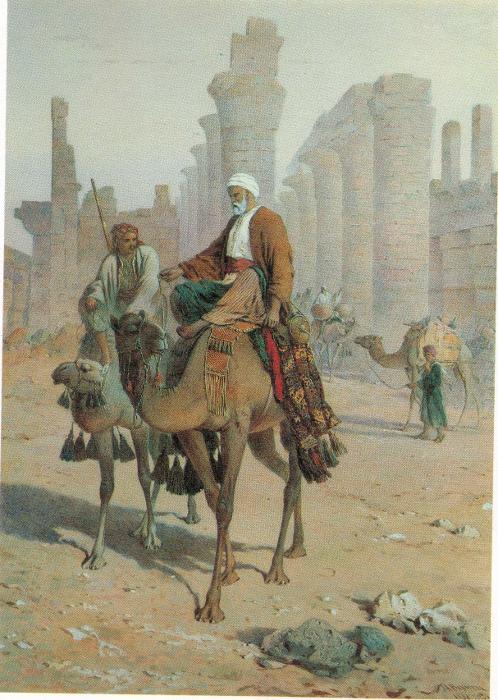
'A caravan by an Egyptian Temple' 1881
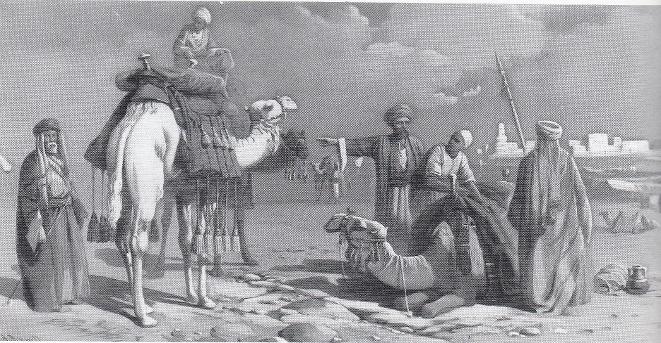
'A caravan on the shore' (8.38 x17ins)
Lot 193, Christie's 28 April 1987
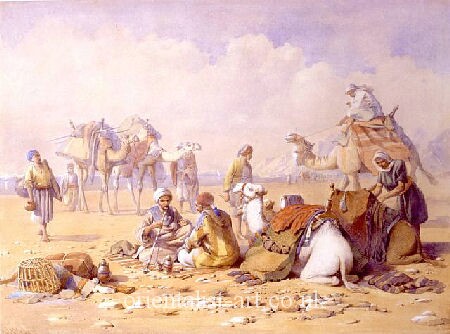
'Halt by the Red Sea', or 'A resting caravan sharing a pipe by the water's edge'

'A halt in the desert' 1865
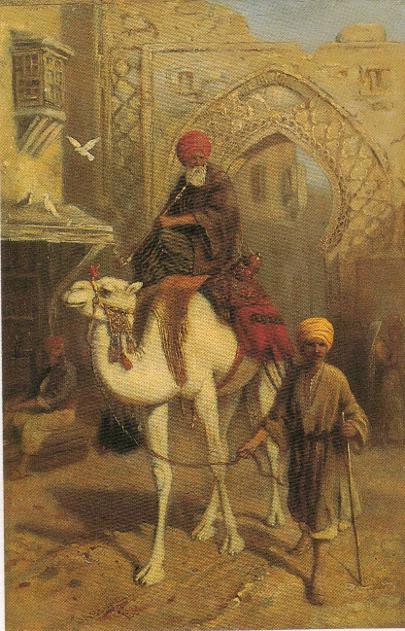
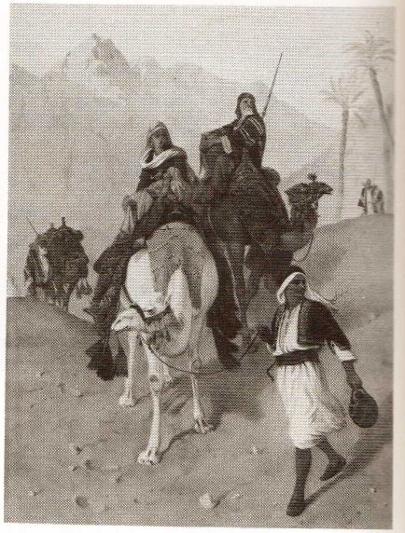
‘A Caravan in the Desert’ 1873. 19.5 x 14.25 in (49.5 x 36 cm),
Lot 138 Sotheby Parke Bernet, London 16 October 1981
'An Arab on a camel in a near-Eastern town' 1881
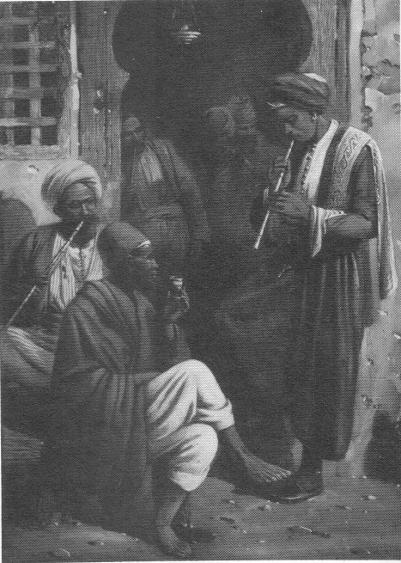
'Outside the cafe' 1867
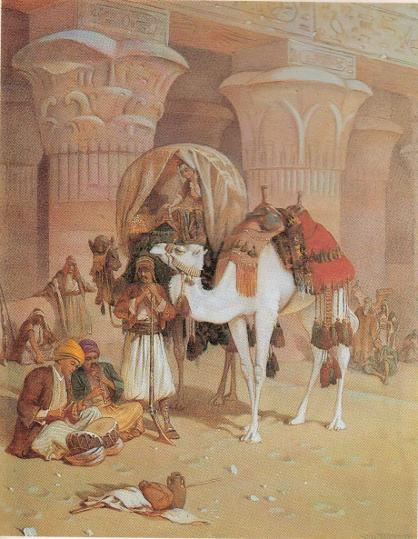
'Kom Ombo, Upper Egypt' 1876
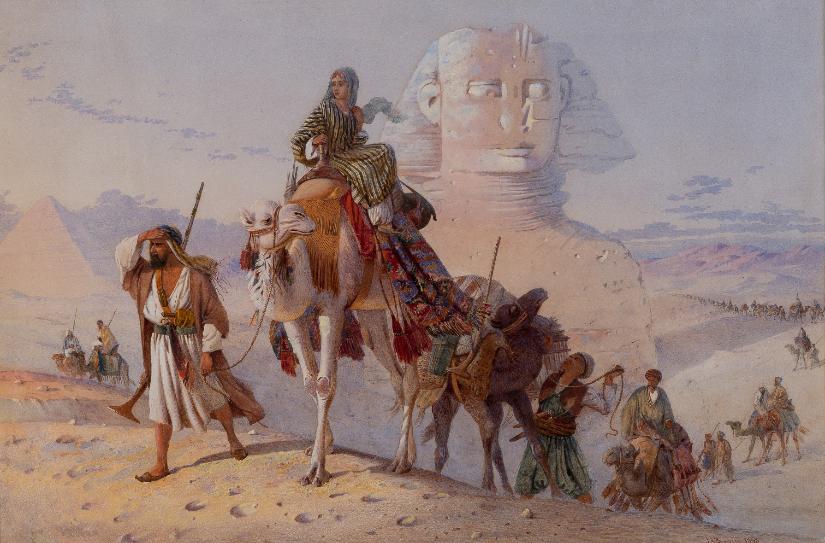
'A Caravan with the Pyramids and Sphinx Beyond' 1868

' 'Outside the Temple of Dendera' 1877
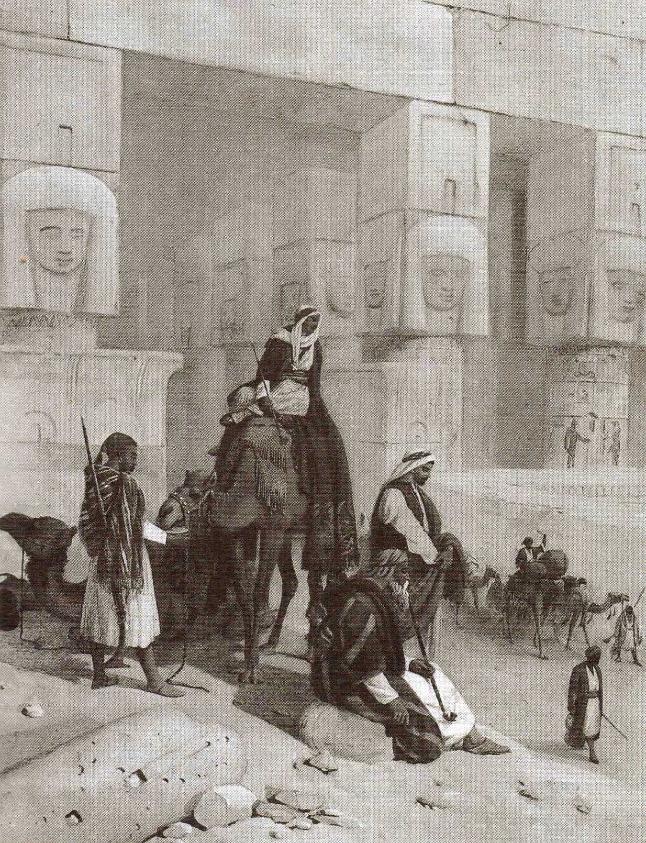
'The Temple of Dendera, Thebes' 1871.
Note the similarities with the later 1877 version showing the same setting, directly above but with different figures. It is likely that Benwell made detailed sketches, and completed some of his later paintings in his studio in Kensington, after returning from his travels. This painting, shown here in black and white, came up for sale by Sotheby's on 15 February 1990 (Lot 230).
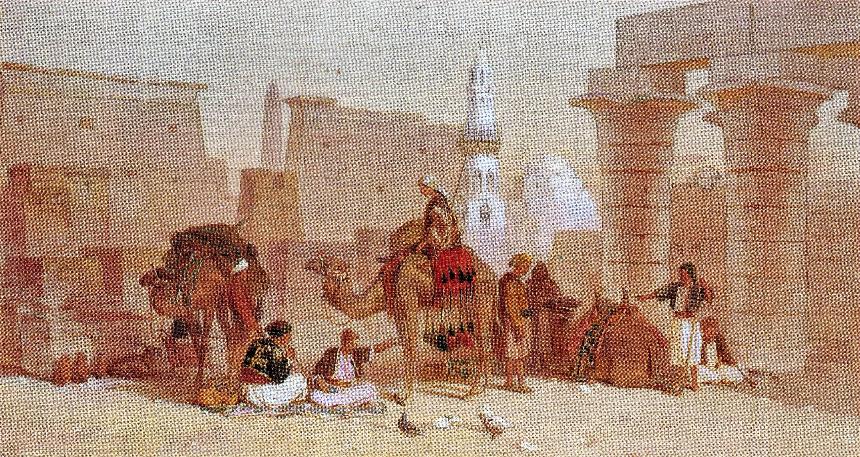
'Arab Traders feeding pigeons near a Mosque' 1874
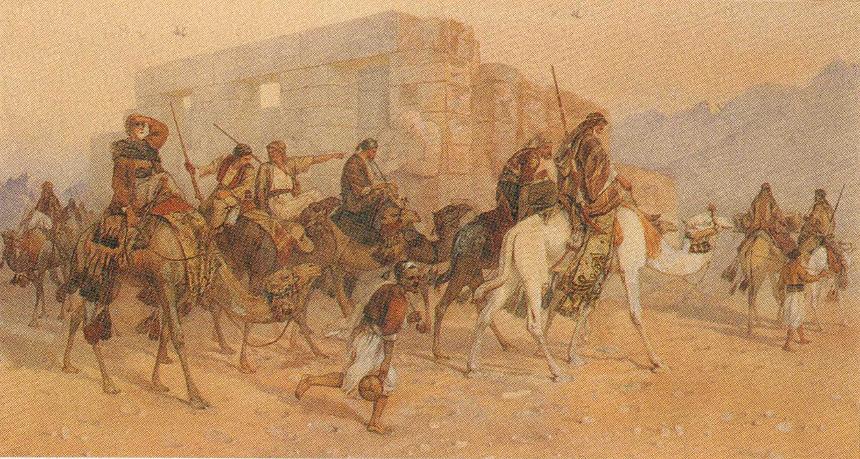
'The Expedition'
Provenance - the clues are there!
1. Old newspapers
Old newspapers can be a useful source of information about paintings, particularly Victorian paintings. You may be able to find out where and when your old picture was exhibited or sold.
A good website to use is The British Newspaper Archive. Searching for the name of the artist may result in articles or advertisements being found - including art exhibitions, art sales and auctions. As well as listings, you may find descriptions of the artwork, which can further aid provenance research.
Listed below are some examples of works by Joseph Austin Benwell that are recorded in various newspaper archives, in descriptions of exhibitions and sales during the second half of the 19th century. This can be a good way to add to the provenance of old artworks, and can provide other clues about a painting’s history.
The Era, 9 November 1862, lecture and exhibition- ‘a set of dissolving views, painted by J A Benwell Esq., from sketches made during a long residence in the cotton-growing districts of India'
Western Daily Press, 21 April 1865, Exhibition at the Bristol Fine Arts Academy- J A Benwell ‘Under Mount Sinai’ - a drawing of camels. Also ‘On the Banks of the Nile, Egypt’
Salisbury & Winchester Journal, 6 June 1866, The Fine Art Exhibition- J A Benwell ‘Travelling in the East Valley of Sinai’
Western Daily Press. 11 June 1866, The Exhibition of the Works of Modern Artists- J A Benwell ‘Mohammedan Pilgrims Sighting Mecca’ ‘A most elaborate bit of work. The camels are executed with the utmost care, and the details of the picture are most cleverly worked in. It presents all the characteristics of a sketch of Oriental life, and is most exquisitely toned.’
Norfolk News, 10 August 1868, the Norwich Fine Art Association- J A Benwell ‘The Welcome Draught’ and ‘En Route to Egypt’ ‘Both are very atmospheric and transparent, and their effect is very pleasing’
Norfolk Chronicle, 12 September 1868, Fine Arts Exhibition- ‘some clever Eastern Scenes, in water-colours’ by J A Benwell.
The Glasgow Herald, 8 April 1869, Glasgow Institute of Fine Arts- J A Benwell ‘Ruined Mosque- Cairo’
The Glasgow Herald, 13 April 1869, The Fine Art Institute Exhibition- J A Benwell ‘Halt for Prayer under Mount Horeb’ (refer to picture below)
London Daily News, 26 April 1869, Fine Arts, The Society of British Artists, Suffolk Street Gallery- J A Benwell ‘Egypt- Pilgrims’
The Norfolk Chronicle & Norwich Gazette, 11 September 1869, Fine Arts Exhibition- J A Benwell ‘The First Halt from Jerusalem’
Western Daily Press, 6 April 1870- Fine Arts Exhibition- ‘Prayer at Old Gaza’ by J A Benwell ‘is a warmly-coloured drawing of an Oriental scene.’
The Examiner and London Review, 23 April 1870, Society of British Artists- J A Benwell ‘Travellers Resting’- ‘the vivid tints and deep shades are well disposed.’
The Graphic, 1 October 1870, Exhibition for the Relief of the Widows and Orphans of Germans killed in the War- J A Benwell ‘Street Scene in Cairo’
The Morning Post, 11 November 1875, The McLean Gallery, Haymarket- J A Benwell ‘The Colossi of the Plain, Thebes- approaching encampment’
Manchester Evening News, 17 September 1879, Atkinson Art Gallery Southport Spring Exhibition- J A Benwell- four studies of desert subjects.(including white camels)
Manchester Courier, 18 September 1879, Whaite’s Exhibition of Watercolour drawings- ‘The numerous Eastern scenes by J A Benwell give a vivid idea of Eastern modes of travel’
Liverpool Mercury,16 October 1879, Walker Art Gallery- J A Benwell ‘Travelling in the Desert (Sinai in the distance)’ ‘a very able drawing by this able painter of Eastern subjects’
Liverpool Mercury, 17 June 1871, Woolton Hall Sale- J A Benwell ‘Arabs Halting’
Birmingham Daily Post, 4 November 1884, Royal Society of Artists- J A Benwell ‘In the Desert, Sinai’
Yorkshire Gazette, 21 August 1880, The York Exhibition- J A Benwell ‘Inquiring the way in the Valley of Sinai’
Birmingham Daily Post, 21 May 1881, Birmingham Royal Society of Artists Spring Exhibition- J A Benwell ‘Mecca Pilgrims passing Maharaka, Nubia’
Bristol Mercury, 16 June 1881, The Fine Arts Exhibition- J A Benwell ‘Mount Sinai’ (sold)
Liverpool Mercury, 2 February 1884 - ‘The First Glimpse of Jerusalem’ by J A Benwell ‘reminds one of Carl Haag’
Liverpool Mercury, 26 April 1884, Whaite’s Exhibition of Water Colours- J A Benwell ‘Jerusalem from Bethany’
Liverpool Mercury, 16 May 1884, Hanover Galleries, important collection of pictures by order of the administrators of the late Peter Douglas Esq. - J A Benwell ‘Near the Walls of Jerusalem’
Bristol Mercury, 6 July 1887, Art Sale (Estate of the late Mr Henry Stevens)- J A Benwell ‘The Summit of Mount Zion, Jerusalem’
Liverpool Mercury, 7 October 1892, sale of choice watercolour drawings and oil paintings, valuable library etc., by order of Trustees in Bankruptcy Davies Bros and Co, Tea Merchants and Estate of John Davies- J A Benwell ‘Arabs in the Desert’
Liverpool Mercury, 28 October 1892, Hanover Galleries, by order of the administrators of the late Mr Joseph Aarons - J A Benwell ‘A Cairo Mule Driver’ (note, this could possibly be The Egyptian Muleteer, shown above)
Extract from 'The Examiner and London Review', 23 April 1870
Extract from 'Liverpool Mercury' 18 June 1871
Extract from 'The Bristol Mercury ' 16 June 1881
Weekly and monthly publications can be a good reference source, as well as newspapers. Benwell is mentioned in a weekly publication called 'Vanity Fair' in 1879 (vol. 21). The following extract indicates that art critics were sometimes inclined to be as forthright and scathing in the 1870s as they can be today!
"There has just been opened in the Albert Hall an exhibition of works of modern artists. I am sorry to say that the exhibition consists of the most part rubbish, but there are a few things worth seeing. The portrait of Lady Rivers on a horse with all his four legs in the air, by Messrs W H Hopkins and E Havell, is good; that of General Nerriman Khan, by Mr Lehmann, is excellent; and there is a masterly watercolour “Sunset in the Desert,” by Mr J A Benwell."
Vanity Fair was a British weekly magazine published from 1868 to 1914. Subtitled "A Weekly Show of Political, Social and Literary Wares", it was founded by Thomas Gibson Bowles, who aimed to expose the contemporary vanities of Victorian society. The first issue appeared in London on 7 November 1868. It offered its readership articles on fashion, current events, the theatre, books, social events and the latest scandals, together with serial fiction, word games and other trivia.
2. Old auction catalogues
Old auction catalogues are a good source of information on the history of paintings as they are bought and sold over the years at various auction houses. They can be very useful for provenance purposes, and sometimes a previous owner can be established. For example, the painting ‘Temple of Isis on the Nile’ was sold by Christie, Manson & Woods at 8 King Street, London on Tuesday February 28th 1893 in a sale entitled ‘Water-colour drawings and modern pictures’ of John Rowland Gibson Esq., deceased, late of 10 Russell Square (Also Water-colour and Drawings from various private sources). In this case, Lots 1-71 were from the collection of John Rowland Gibson, and lots 83-120 were from ‘Another property’.Although we cannot establish the name of the owner in this instance, we do know that the previous owner also had a Constable in his/her collection!
Extract from 1893 auction catalogue shown below.
Useful information in tracing provenance can often be gleaned from old auction catalogues. In this catalogue from 1908 many of the paintings are ascribed to previous owners, for example "The property of Mrs Hannah Entwhistle, deceased". The Benwell painting in this particular catalogue, 'In the Land of Egypt' is one listed as being from "Different properties" so the previous owner is not specified. However, the date of the painting is given (1865), and also the measurements can help confirm its provenance. As seen in the extract below, the catalogue has been most helpfully inscribed with hand-written prices alongside each lot! This would presumably be the hammer price achieved rather than the estimate (as the prices are quite specific). Unfortunately it is only in more recent years that auction catalogues consistently have accompanying illustrations for some or all of the lots.
3. Old exhibition catalogues
Old exhibition catalogues are also a useful source of information on artists’ works. Some have been digitised and are available online. For example, the catalogue for the London International Exhibition 1873, held in South Kensington, and the catalogue for the Sydney International Exhibition in 1879-80 (refer below).
Artists’ names and auction/exhibition catalogues can be searched for online on websites containing digital versions of old books and catalogues, such as HathiTrust.org. A good place to start is the WorldCat website to search library collections worldwide, including all editions and various formats of the documents. The website gives availability of publications in libraries and also online/digital format. The website has the option of just searching for publications that are available as e-books to view online (under ‘format’ on the left-hand side).
Actual hard copies of old auction and exhibition catalogues can be purchased on eBay and specialist websites such as The CatalogStar.com. More recent catalogues, from about the 1980s, are relatively easy to track down. If you have purchased an old painting, it is definitely worthwhile trying to find old auction or exhibition catalogues featuring the painting, maybe going back many decades. It all helps towards the provenance and it is fascinating to trace the history of your painting.
Extract from “Bristol Art Gallery: Catalogue with descriptive notes, of the permanent and seventh loan collection of pictures, and the collection of statuary “ compiled by Richard Quick, 1908.
This may well be the painting of the same name (Halting by the Sphinx) and date (1873) that was sold in December 1907- refer to 'Art Prices Current' under item 4 below. Possibly it was a recent acquisition by the new owner. Also refer to the section on the Benezit Dictionary, below.
Extract from the Royal Institute of Painters in Watercolours, A Catalogue of the 66th Exhibition 1884, Piccadilly, London. Number 833 in the East Gallery is 'Pilgrims passing the Sphinx' by J A Benwell. This type of catalogue is particularly useful for family historians, as at the end it gives the addresses/residences of the exhibiting artists. At the time, Benwell was listed as being resident at 13 Abingdon Villas, Kensington.
'Mecca Pilgrims passing the Sphinx' 1884. This is likely to be the same painting 'Pilgrims passing the Sphinx' in the above exhibition catalogue from 1884. It sold at Phillips Auction house over a hundred years later on 31 January 1994 for £1,300 (Artnet).
Extract from page 17 of the Sydney International Exhibition (1879-80) catalogue shown below
Extract from the Catalogue of the Preston Exhibition, opened August 9th 1875, at the Corn Exchange, Preston.
120 - Approaching the Encampment' J A Benwell
4. Miscellaneous books and art price publications
Miscellaneous books and art price publications. A useful example is the series 'Art Prices Current', published by the London Offices of the Fine Art Trade Journal, which lists auction sale results for works of art sold during the year. Volume 1 covers the year 1907/08, and was published in 1908. Volumes 1-9, covering the period 1907/08 to 1915/16, have been digitised and are available online on The Internet Archive. Most of the listings are for Christie's sales, and later volumes include other auction houses. Extracts are shown below, including Benwell's 'A Camel Caravan', sold in June 1908, and 'Halting by the Sphinx' (1873), sold in December 1907. The inclusion of measurements of the paintings, and the year, provide a useful cross-check for identification purposes.
This extract gives useful information about several of Benwell's paintings, including 'Halt near the Sphinx', 'The Temple of Isis', 'Characters from the Orient- Studies of Arabs' and 'In the Land of Egypt'. The entry also notes that Bristol Museum has 'Halt near the Sphinx' in its collection (as of 1924). I contacted the museum, but they were unable to say whether or not they still had the painting, or what happened to it.
Other useful publications include books such as 'Works Exhibited at the Royal Society of British Artists, 1824-1893 and the New English Art Club, 1888-1917’ (J Johnson, Antique Collectors’ Club, 1975).
It lists some of Benwell’s Orientalist paintings that were exhibited at the Royal Society of British Artists between 1866 and 1886. Shown below is an extract from this publication. To date, I am not aware that it has been digitised for the public domain, and I went to the Tate Reading Rooms to see a copy.
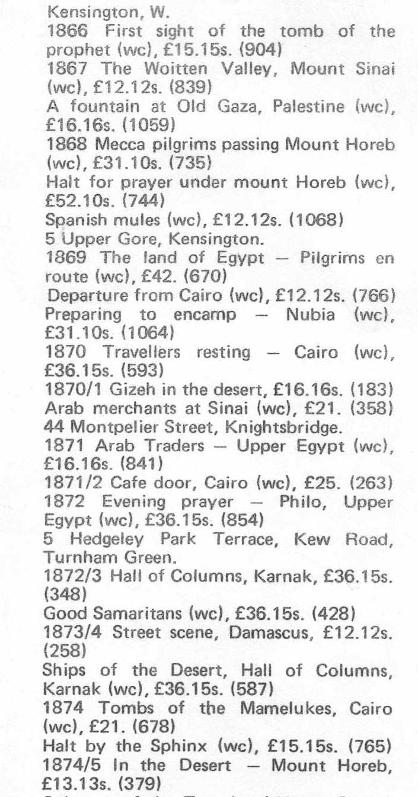
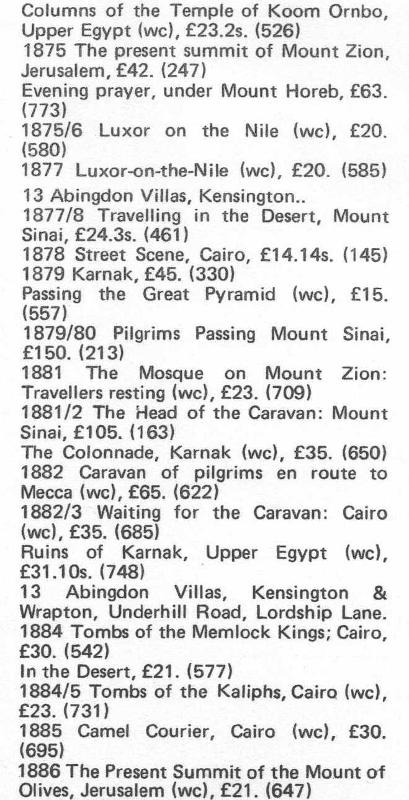
Titles of paintings can change! Some of those listed may in fact refer to paintings that are known by another name today. In fact, so far I have not been able to match many of these with current internet records. Either there have been a few changes in title, or there are many paintings out there that have not been recorded or listed during the past few decades. This is something to be aware of in your research.
An example of changing titles of paintings over the years is that of Benwell’s ‘A Rest before the City Gates’ (Lot 180 Christie’s sale 1 Oct 2008). Art auction catalogues in the relatively recent past list it as 'Arabs resting outside a town' (Lot 173 Christie's sale 29 Nov 1984 and Lot 134, 13 Dec 1983), and 'Arabs resting on the outskirts of a City' (Lot 451, Sotheby's sale 6 Nov 1985). The image is the same as the more recent acquisition, although the precise measurements vary a little; this is because, as related above, the painting was re-framed and given a new mount in the 1980s, which covered the signature and most of the date and made the image appear fractionally smaller. In this case it is clear that it is the same painting. Of course, it may not be wise to presume in the same way for other paintings, particularly when an artist is known to have painted similar or identical scenes. If the title can change over the course of a few decades in recent years (when better records are kept), then it is quite likely that this also occurred over longer periods of time in the past. This painting may have been known by a completely different title in the nineteenth century. Also refer to 'The Great Sphinx of Giza' below, another example of changing titles.
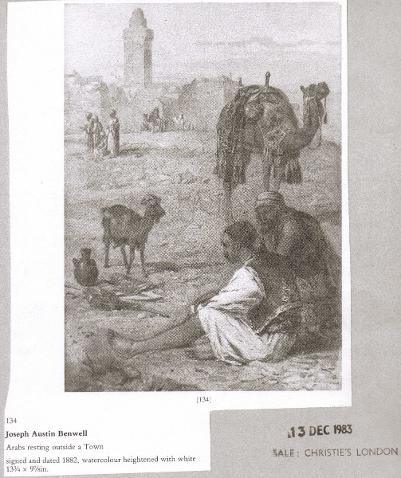
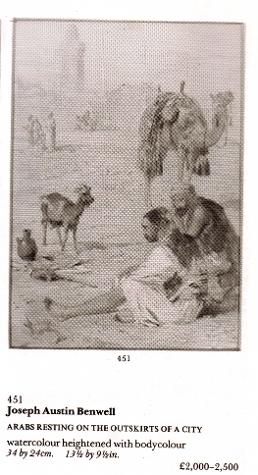
'Arabs resting outside a Town', Christie's 13 Dec 1983 'Arabs resting on the outskirts of a City', Sotheby's 6 Nov 1985
13 3/4 x 9 7/8 in. 13 1/2 x 9 1/2 in. (34x24cm)
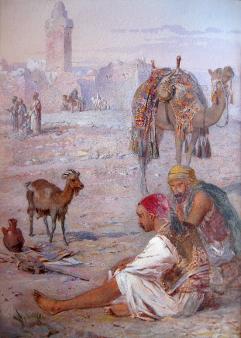
Same painting - different titles
' A rest before the City gates', Christie's 1 Oct 2008
13 3/8 x 9½ in. (24.2 x 34 cm.)
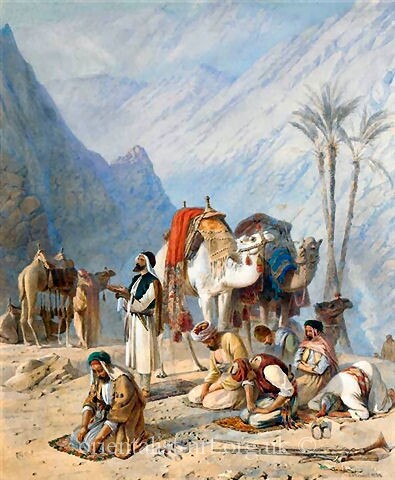
'Halt for Prayer under Mount Horeb' 1865
Exhibited at the Royal Academy 1865, No. 627, South Room (The Exhibition of the Royal Academy of Arts, The Ninety-Seventh, 1865)
Extract from the Glasgow Herald 13th April 1869, The Fine Art Institute Exhibition: “J A Benwell has a piece of rich warm colour in the ‘Halt for Prayer under Mount Horeb’, No. 635. The impression of dazzling sunshine and sweltering heat, appropriate to an Eastern desert, is effectively conveyed; nor has the artist spared his pains in delineating the worshipping Arabs, and the drowsy-looking camels, whose bright coloured housings help to enliven the scene. As a whole, the drawing is forcibly suggestive of Eastern scenery and of an interesting phase of Oriental life”
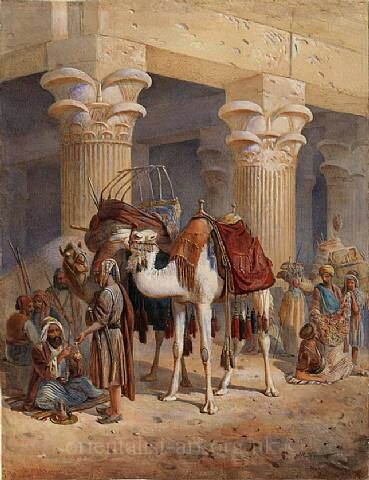
'Eastern Merchants'
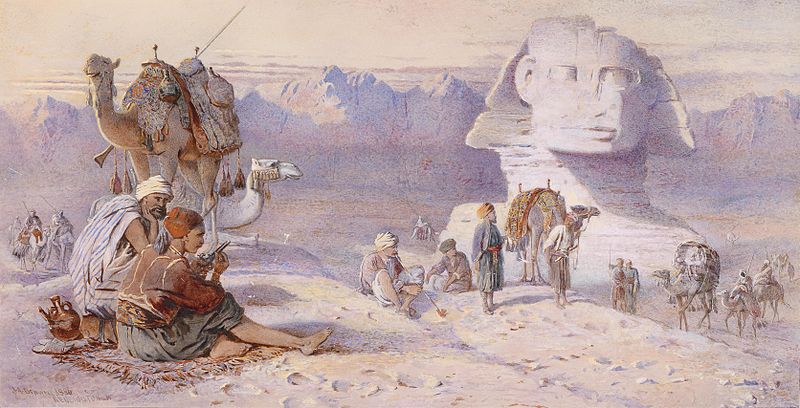
'The Great Sphinx of Giza' 1886 (or, 'Resting caravan in front of the Sphinx of Giza'; or, 'Halt by the Sphynx, Egypt')
Signed and dated lower left- J A BENWELL. 1886, KENSINGTON. W.
Referenced in 'Art Prices Current, 1909-10, Vol III, A Record of Sale Prices at Christie's during the Season' , publ, London, Offices of the Fine Art Trade Journal, on December 13, 1909: 114. Benwell J A (1886) 'Halt by the Sphynx, Egypt' 13 x 26 (Sampson). This may be the original title of the painting.
Sold on 15 September 2010 by Bonhams as 'The Great Sphinx of Giza', and previously by Sotheby's on 3 December 2002 as 'The Sphynx'.
Sold on 10 May 2015 by Kunstauktionshaus, Schloss Ahlden, Germany as 'Rastende Karavane vor der Sphinx von Gizeh' (or 'Caravan at rest with the Great Sphinx of Giza beyond')
Note that the Sphinx is shown buried in sand up to the shoulders. Partial excavations were made in the 1870s. The entire Sphinx was excavated in 1925-1936.
The painting must have been completed in Benwell's studio at 13 Abingdon Villas, Kensington, based on sketches and previous studies/artworks of this subject. not long before his death on 13 May 1886. It is likely to be one of his last works, possibly his last. I have counted twelve camels in this painting.
Signature on 'Halt by the Sphynx'
'The Wandering Musicians' 1867

'The Evening Halt'
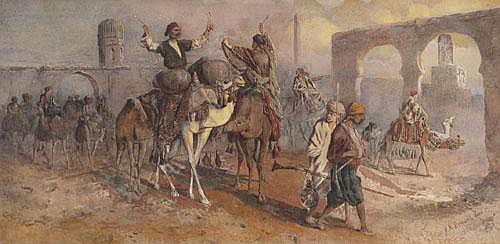
'Arabian Market'
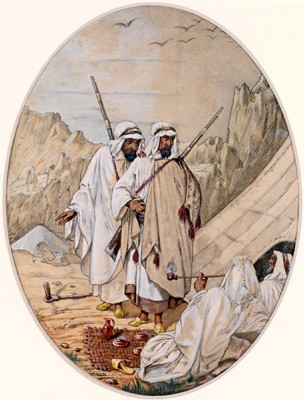
'Resting Arabs in the desert mountains'
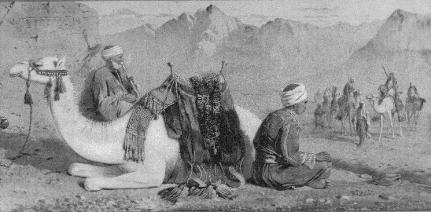
'Halt in the Written Valley, Desert of Sinai' 1883
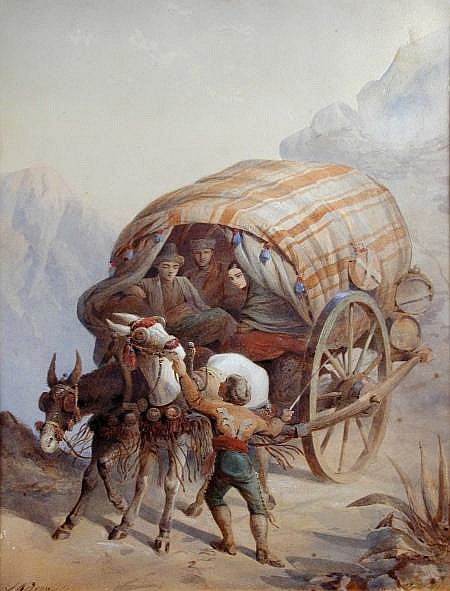
'A Mule Cart in the Alps'
note: the figures appear Eastern in appearance and in the author's opinion the scene is more likely to be set in the Himalayas, where other of JAB's illustrations were set.
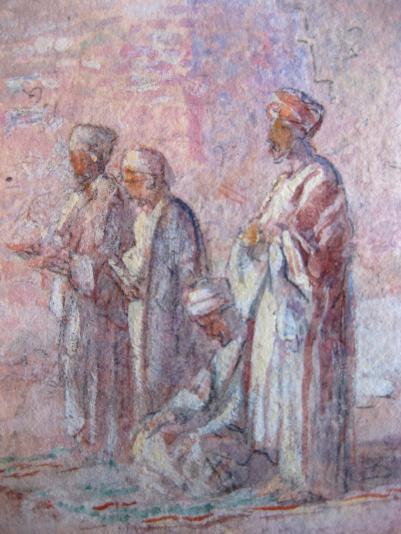
Magnified detail from background of ' A Rest before the City Gates' (above), showing Arabs at prayer
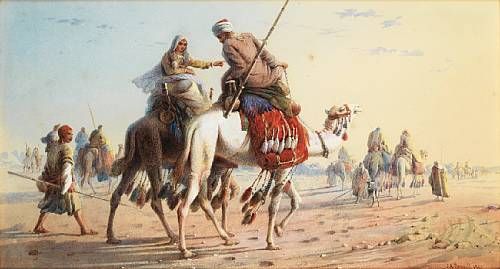
'Bedouin Caravan in the Desert' 1867
This same painting is referred to as 'Caravan in the Desert', dated 1864 in a couple of reference sites. The 1864 date may be incorrect, based on a 2010 auction. The date in lower right hand corner appears to be 1867.
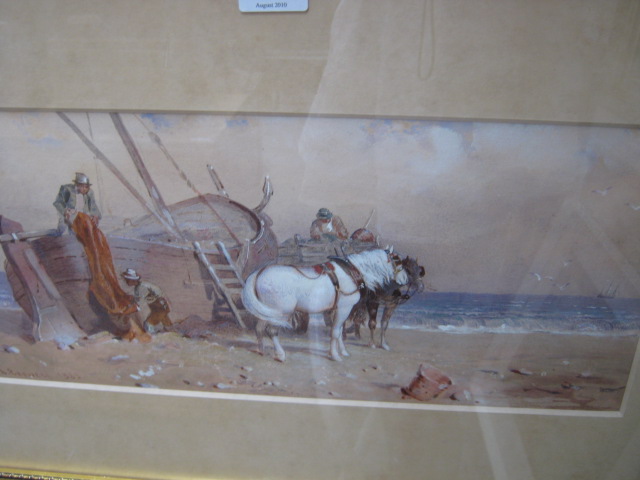
'Beach scene' 1883
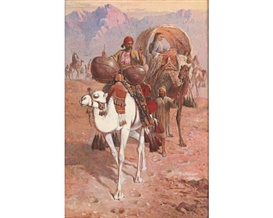
'The Head of the Caravan, Mount Sinai' 1882
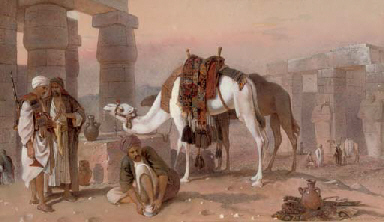
'Egyptians and their camels resting by a Temple' 1877, or ‘Arabs watering their camels by ruins’
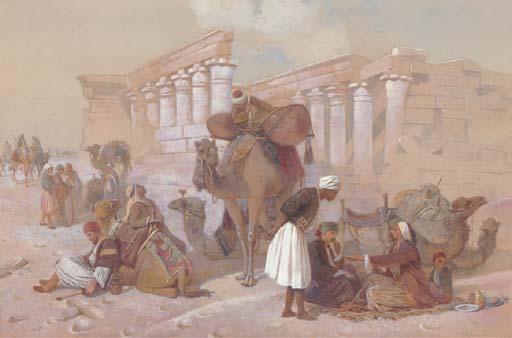
'Arabs with their camels by temple ruins' 1873

Magnified detail from background of ''A Rest before the City Gates' (above) - the famous 'White Camel' makes a more elusive appearance
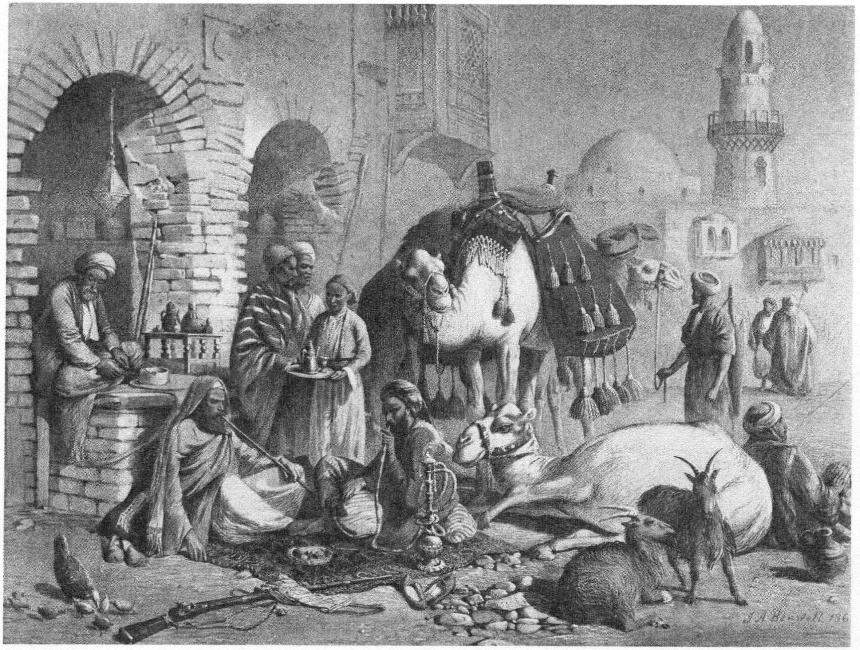
'Coffee Shop in the Via Dolorosa, Jerusalem' 1865
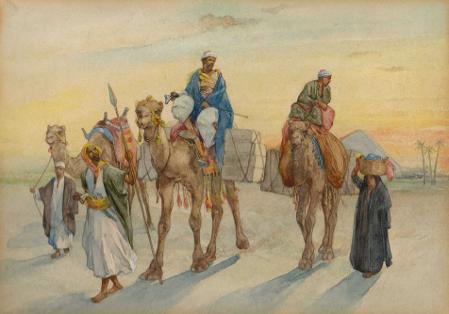
'Desert Travellers' Attributed to Joseph Austin Benwell, inscribed on the back
'Edward Julius Detmold'. Refer Desert Travellers- An Enigma?
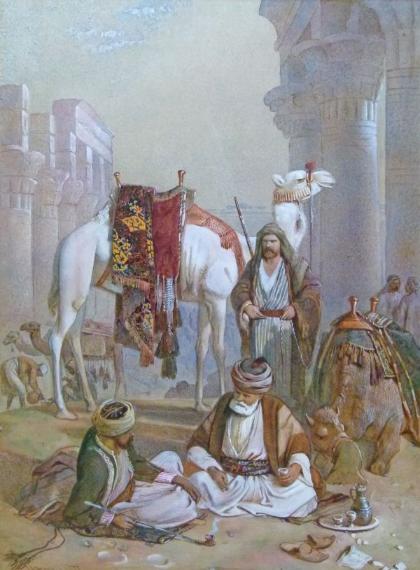
'The Temple of Isis, Philae' 1877 or, 'Arabs drinking coffee and smoking at the Temple of Isis, Philae'
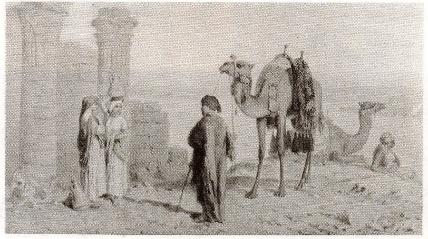
10 x18.25in (25.5 x 46.5cm). Lot 126 Sotheby Parke Bernet, London 16 October 1981
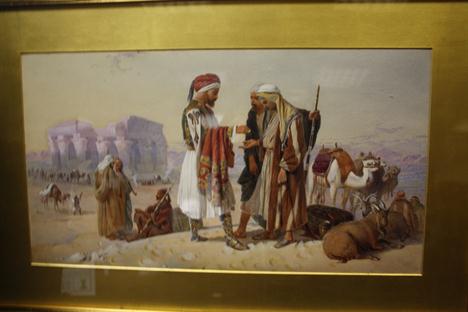
'Egyptian Tradesmen standing before ruins'
'The Board Game' 1870
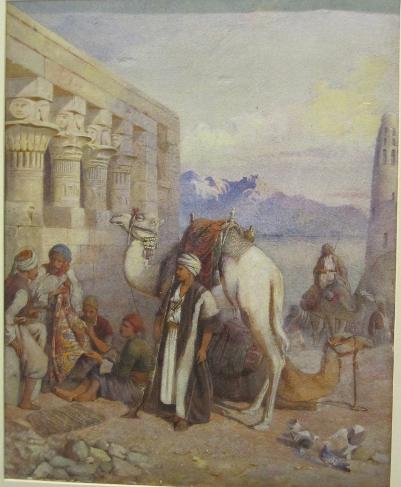
'Carpet Dealers at Philae' 1885 (Victoria & Albert Museum)
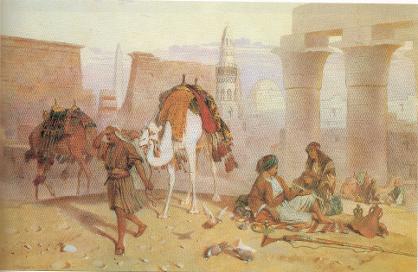
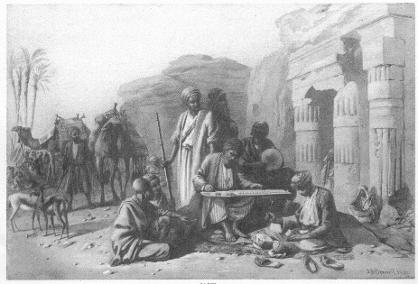
' Resting among Egyptian ruins at evening' 1875 'Egypt: music outside a Temple' 1867, or 'The wandering Musicians'
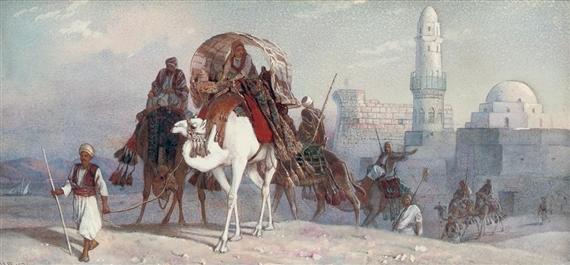
'The Desert Caravan, Egypt' 1874, or ' A Camel Train leaving Luxor'
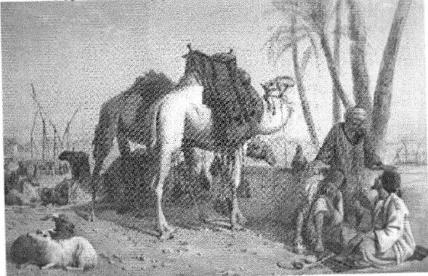
'Bedouins resting by the Nile'
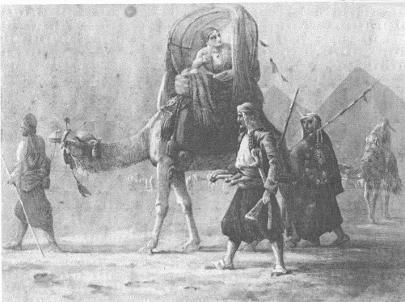
''Caravan passing by the Great Pyramids'
As a Benwell descendant, I am interested in acquiring J A Benwell's paintings and artworks in order to bring some back to the family. I would be interested to hear from anyone wishing to sell one of his works. Or if you just want to find a good home for a piece that is no longer wanted, please let me know. (please see 'contact' page)
Suscribirse a:
Entradas (Atom)













































